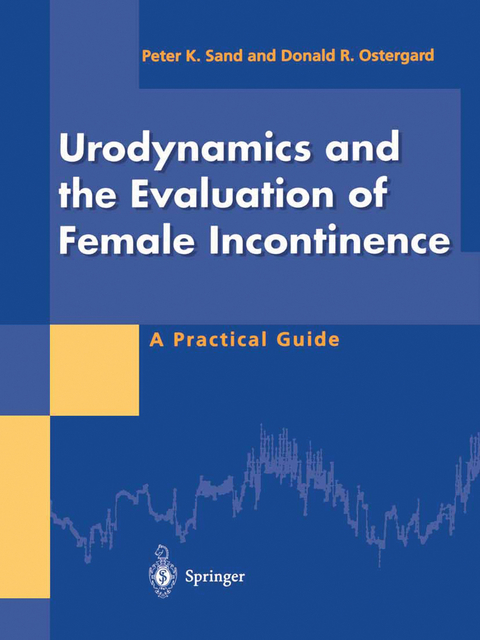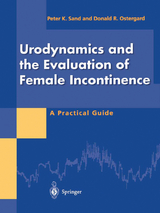Urodynamics and the Evaluation of Female Incontinence
Springer Berlin (Verlag)
978-3-540-19904-5 (ISBN)
Urodynamic evaluation of the incontinent female has come of age. It is no longer accept able to subject women to surgical procedures for urinary incontinence based solely on the physician's clinical impression of the cause of the urine loss. Multiple studies in the uro gynecological literature have told us that the error rate for stress incontinence is about 25% and the error rate for the unstable bladder is 50% when these diagnoses are based solely on historical data obtained from the patient. Unfortunately the patient is a poor witness to her bladder's activities and diagnoses arrived at without further evaluation are subject to error. Urodynamic testing allows the establishment of precise diagnoses using procedures that have been proven to be accurate. For the physician who has not had the opportunity to have fellowship training, the uro dynamic tracing is sometimes more of a mystery than a diagnostic aid. Physician training in the reading of urodynamic tracings is limited to piecing together information from the literature, textbooks and postgraduate courses. Unfortunately none of these sources can provide the experience necessary to become an expert in the interpretation of the physio logical and pathophysiological events depicted on the tracing. Artifacts occur commonly and may lead to misinterpretation of these events and even misdiagnosis if the reader of the tracing is not careful and fully informed on the nuances of the testing procedures. This is why this text was conceived as an atlas of urodynamic testing procedures.
Section I: Routine Office Evaluation.- 1 The Female Urologic History.- 2 Voiding Diaries.- 3 Uroflowmetry in the Female.- 4 The Lumbosacral Neurologic Examination.- 5 The Gynecologic Pelvic Examination.- 6 The Q-Tip Test.- 7 Urethral Calibration.- 8 Stress Testing.- 9 Pad Testing.- Section II: Cystourethroscopy and Cystometry.- 10 Dynamic Urethroscopy.- 11 Supine Urethroscope Cystometry.- 12 Cystoscopy.- 13 Standing Single Channel Cystometry.- Section III: Multichannel Urodynamics: Normal Studies.- 14 Who Needs Urodynamics?.- 15 Urethral Closure Pressure Profiles.- 16 Augmenting Urethral Closure Pressure Profiles.- 17 Dynamic Urethral Closure Pressure Profiles: Valsalva and Cough Profiles.- 18 Urethral Responses to Position Changes.- 19 Urethral Responses to Bladder Filling.- 20 Multichannel Urethrocystometry.- 21 Voiding Pressure Studies.- Section IV: Multichannel Urodynamics: Pathologic Studies.- 22 Genuine Stress Incontinence.- 23 Pressure Transmission Ratios.- 24 Detrusor Instability.- 25 The Acontractile Bladder.- 26 Detrusor Sphincter Dyssynergia.- 27 The Low Compliance Bladder.- 28 Genital Prolapse.- 29 The Low Pressure Urethra.- 30 Urethrovaginal Fistulas.- 31 Urethral Diverticula.- 32 Urethral Instability.- 33 Uninhibited Urethral Relaxation.- Section V: Special Tests.- 34 Prolapse Pessary Tests.- 35 Urethral Denervation Testing.- 36 Vesical Denervation Testing.- 37 The Bladder Cooling Test.- 38 The Stop lest.- 39 Pelvic Floor Stimulation: Effect on Detrusor Activity.- 40 Pelvic Floor Stimulation: Effect on Urethral Closure Pressure Profile.- 41 The Effect of Hypogastric Nerve Block on Detrusor Instability.- 42 The Effect of Pudendal Block on the Urethral Closure Pressure Profile.- 43 Leak Point Pressure Testing.- Section VI: Urodynamic Artifacts.- 44 Rectal and Vaginal Peristalsis.- 45 Transducer Placement and Poor Calibration.- 46 Filling Catheter Artifacts.- 47 False Negative Cough Profiles.- 48 Transducer-Induced Artifacts.- Section VII: Postoperative Urodynamics.- 49 The Effect of Retropubic Urethropexy on the Resting Urethral Closure Pressure Profile.- 50 The Effect of Retropubic Urethropexy on the Dynamic Urethral Closure Pressure Profile.- 51 The Effect of the Suburethral Sling Procedure on the Dynamic Urethral Closure Pressure Profile.- 52 Postoperative Detrusor Instability.- 53 Type III Stress Incontinence.- Appendices.- Appendix A Office Treatment of Urinary Incontinence.- Appendix B Terminology of Lower Urinary Tract Function.- Appendix C Recording Forms for Urodynamics and Evaluation of Urinary Dysfunction.- Appendix D Self Test.
| Erscheint lt. Verlag | 28.6.1995 |
|---|---|
| Zusatzinfo | X, 271 p. 28 illus. |
| Verlagsort | London |
| Sprache | englisch |
| Maße | 210 x 280 mm |
| Gewicht | 1022 g |
| Themenwelt | Geisteswissenschaften ► Psychologie ► Klinische Psychologie |
| Medizin / Pharmazie ► Medizinische Fachgebiete ► Gynäkologie / Geburtshilfe | |
| Medizin / Pharmazie ► Medizinische Fachgebiete ► Urologie | |
| Medizin / Pharmazie ► Physiotherapie / Ergotherapie ► Rehabilitation | |
| Schlagworte | Age • Care • Diagnosis • Dynamics • Evaluation • Female Incontinence • HC/Medizin/Klinische Fächer • incontinence • Inkontinenz • lead • patients • Pelvic Floor • Stress • Training • Treatment • Urinary Incontinence • Urologie • Women |
| ISBN-10 | 3-540-19904-7 / 3540199047 |
| ISBN-13 | 978-3-540-19904-5 / 9783540199045 |
| Zustand | Neuware |
| Haben Sie eine Frage zum Produkt? |
aus dem Bereich





